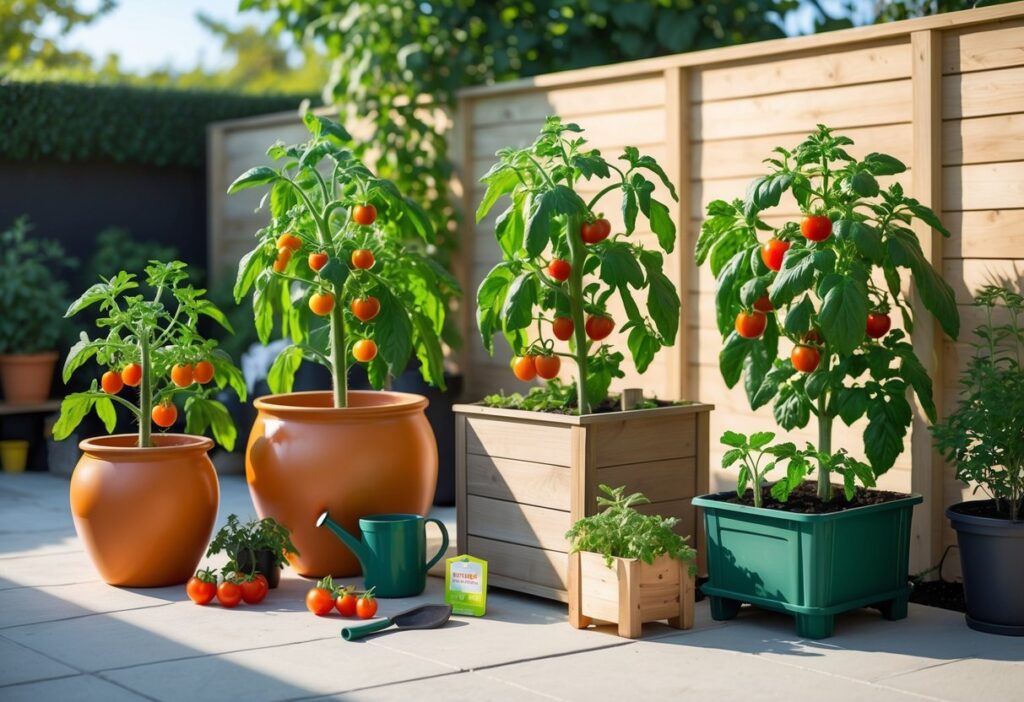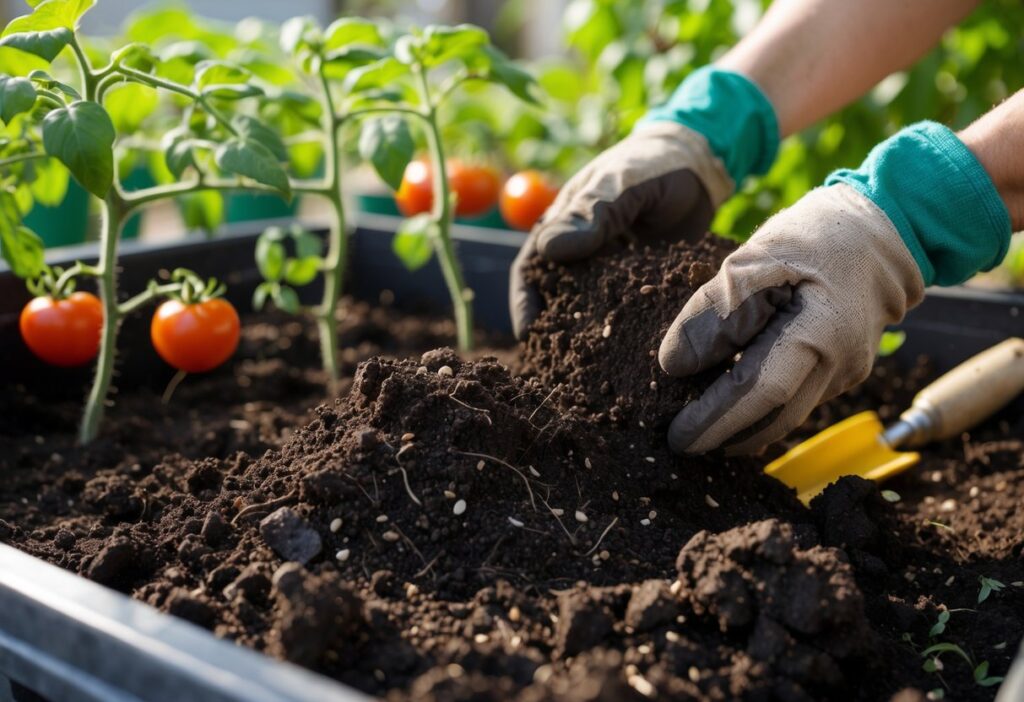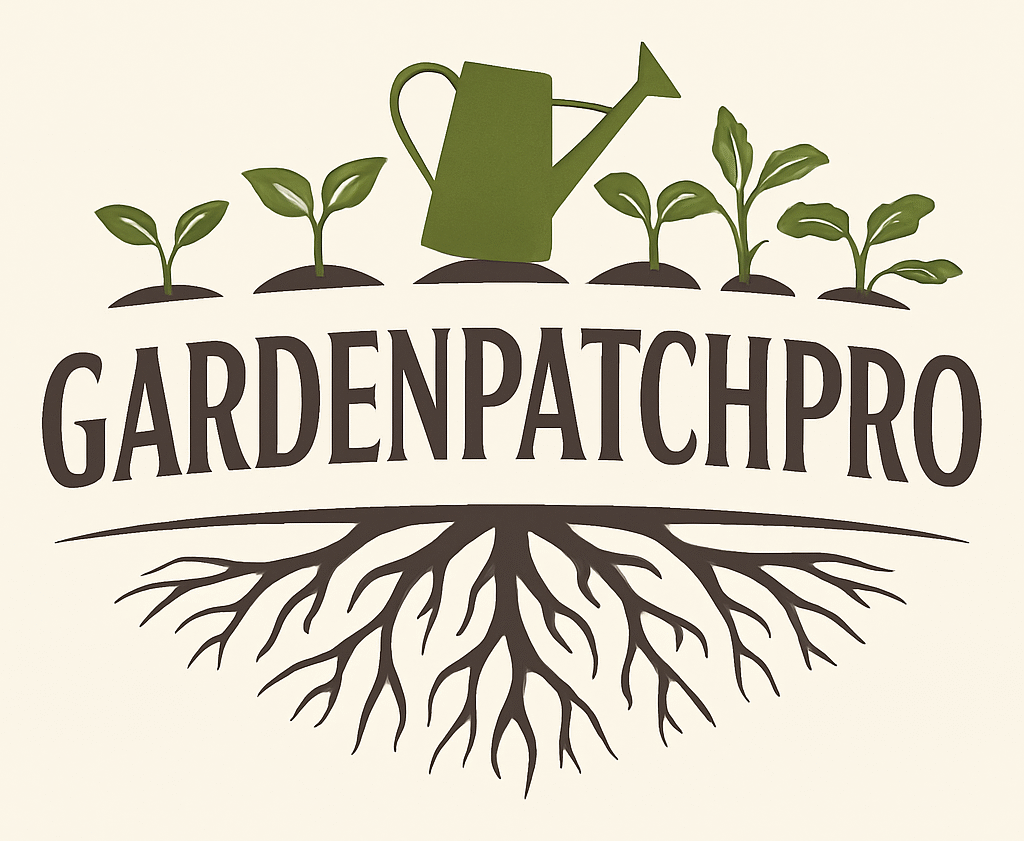How to Grow Tomatoes in Containers: The Complete Step-by-Step Guide
Growing tomatoes in containers is a smart way to enjoy fresh, homegrown tomatoes even without a garden or yard space. With the right containers, good soil, and proper care, anyone can successfully grow healthy tomato plants on a patio, balcony, or small deck. This method saves space and allows for easier control of the growing environment.

Choosing the correct tomato variety and planting it at the right time improves the chances of a bountiful harvest. Container gardening also means regular watering, fertilizing, and pruning are key to keeping plants strong and productive. Proper sunlight and support systems help tomatoes thrive in limited spaces.
By understanding how to balance these basic needs, growing flavorful tomatoes in containers becomes a straightforward and rewarding experience. This guide will explain what’s needed to start and maintain a container tomato garden with confidence.
Key Takeaways
- Use suitable containers and quality soil for healthy tomato growth.
- Select tomato types that match container size and space.
- Maintain plants with consistent care for best fruit yield.
Choosing the Best Containers for Tomatoes

Picking the right container is key to growing healthy tomatoes in pots. The size, material, and drainage features affect root growth, moisture levels, and plant stability. How the pot is placed also influences sun exposure and temperature control.
Selecting Container Size and Materials
Tomatoes need at least a 5-gallon pot for healthy root growth. Larger containers provide room for roots to spread, supporting better plant health and fruit production. Small pots can work for dwarf or cherry tomato varieties, but anything smaller may limit growth.
Materials like plastic or resin are practical because they retain moisture longer and are lighter to move. Terra cotta looks nice but dries out faster and gets hot in the sun, which can stress plants. Light-colored pots help prevent soil from overheating. Regardless of material, the container must be sturdy enough to support the plant as it grows.
Ensuring Proper Drainage and Drainage Holes
Good drainage is critical for tomatoes. The container must have several drainage holes at the bottom to prevent water from sitting in the soil. Waterlogged roots cause rot and poor plant health.
If the chosen pot lacks sufficient holes, it’s important to add them before planting. Using a saucer under the pot can catch excess water, but standing water must be emptied regularly to avoid root damage. Proper drainage keeps the soil moist but not soaked, which helps prevent problems like blossom-end rot.
Positioning and Pot Placement
Tomato pots should be placed where they receive 6-8 hours of direct sunlight daily. South or southwest-facing spots are ideal for best fruit ripening. Container gardening allows moving the pot to follow the sun or avoid harsh winds.
Using a pot with casters or placing it on a movable stand makes repositioning easier. Avoid shady, drafty, or cold spots since containers heat and cool faster than ground soil. Keeping the pot off cold surfaces, like concrete floors, can protect roots from chilling.
Preparing Soil and Fertility for Tomato Plants

Healthy tomato plants in containers need the right soil mix and added nutrients to grow strong and produce fruit. Proper drainage, air flow, and balanced feeding are key. Using quality ingredients and keeping the soil loose will help roots develop well and absorb water and nutrients efficiently.
Selecting Potting Mix and Soil Ingredients
The foundation for tomatoes in pots is a well-draining, nutrient-rich potting mix. A good mix often combines peat moss or coco coir, vermiculite or perlite, and compost.
- Peat moss or coir helps keep the soil moist without waterlogging.
- Vermiculite or perlite improves drainage and air spaces to prevent root rot.
- Compost adds nutrients and supports beneficial microbes.
Mix these in roughly equal parts (1:1:1 ratio) for a loose, crumbly texture that holds moisture but drains well. Commercial potting soils labeled for vegetables or tomatoes are also good ready-made options.
Amending with Compost and Nutrients
Adding organic matter like compost or vermicompost boosts fertility and soil life. It supplies essential nutrients gradually and improves soil structure.
For balanced feeding, tomatoes need nitrogen, phosphorus, and potassium. Natural fertilizers like bone meal provide phosphorus to support root and fruit development. Mixing slow-release fertilizers targeted for tomatoes into the soil ensures steady nutrient supply during the growing season.
Regular feeding with tomato-specific fertilizer or occasional compost tea helps keep plants strong. Avoid over-fertilizing, which can cause excessive leaf growth without fruit.
Avoiding Garden Soil in Pots
Using garden soil in containers is not recommended. Garden soil is often too dense and can become compacted in pots, restricting root growth and drainage. Poor drainage causes waterlogging and root diseases like rot.
Containers require a lightweight, well-aerated soil mix designed for potted plants. Using garden soil can also introduce pests and soil-borne diseases harmful to tomato plants.
For best results, a sterile commercial potting mix or homemade mix with peat moss, perlite, and compost should be used to support root health.
Mulching for Moisture Retention
Mulch helps keep the potting soil moist and temperature stable. It reduces evaporation, so watering is needed less often. Organic mulches such as straw, shredded leaves, or compost also add nutrients slowly as they break down.
Applying a 1-2 inch layer of mulch on top of the soil surface in containers helps prevent the soil from drying out too quickly. This practice maintains consistent moisture essential for tomato plants, especially in warm, dry conditions.
Mulching also suppresses weed growth and protects roots from extreme heat.
Choosing and Planting Tomato Varieties

Selecting the right tomato type and knowing how to start and space the plants are key for success in containers. Certain varieties fit pots better due to their size and growth habits. Whether beginning from seeds or young plants, proper handling affects how well tomatoes grow. Planting depth and space influence root health and fruit production.
Best Tomato Varieties for Containers
Determinate tomato varieties are often best for containers because they grow to a set size and produce fruit all at once. Examples include Patio Choice Yellow and Supremo Roma. These types stay compact, making them easier to manage in pots.
Indeterminate varieties like Sweet Million and Chocolate Cherry continue to grow and produce fruit all season but need larger containers and support such as cages or stakes.
Cherry tomatoes like Tumbling Tom and Sun Gold are popular for containers because of their smaller size and high yield. Roma tomatoes, known for their sauce quality, also work well in containers when the pot is large enough.
Starting from Seed vs. Transplanting
Starting tomatoes from seed gives growers more variety choices and control over timing. Seeds should be sown indoors about six to eight weeks before the last frost date using seed-starting soil and a warm, well-lit area.
Transplants, or young plants bought from nurseries, provide a quicker way to get tomatoes growing in containers. They reduce the waiting time and are usually stronger, which helps with early growth.
Either way, plants moved outdoors need to be hardened off first. This means slowly exposing them to outdoor conditions over a week to prevent shock.
Planting Depth and Spacing
Tomatoes planted in containers should go deep enough to cover most of the stem. This encourages better root development and stronger plants.
Container size affects spacing. For determinate types, pots should be at least 5 gallons with 18 inches diameter, spaced so plants don’t overcrowd. Indeterminate tomatoes need larger pots, 10 gallons or more, and about 24 inches between plants if multiple containers are used.
Good drainage and fresh, well-draining potting mix are essential. Crowded plants risk poor air flow and disease. Proper depth and spacing ensure healthy growth and better yields.
For more detailed variety choices, see Growing Tomatoes in Containers from Epic Gardening.
Caring for Tomato Plants in Containers

Tomato plants in containers need steady attention to grow well and produce fruit. Proper sunlight, watering, support, and feeding are crucial. Each step helps keep the plant strong, healthy, and productive throughout the growing season.
Sun Exposure and Light Requirements
Tomato plants need at least six to eight hours of direct sunlight every day. This amount of sun is essential for flowering and fruit development.
Containers should be placed in a spot that gets sun from late morning to early afternoon, roughly between 10 a.m. and 4 p.m. The position may need to change as the sun moves during the season.
Tomatoes also prefer warm temperatures. If it gets too cold, below 50°F, they should be moved indoors or protected. If temperatures climb above 90°F, providing some shade helps prevent the plants from stopping flower and fruit production.
Watering Techniques for Healthy Plants
Container-grown tomatoes need consistent watering because pots dry out quickly. The soil should be moist but never soggy to avoid root rot.
Water early in the morning to let leaves dry during the day, which helps stop diseases like blight. Avoid watering the leaves; focus on the soil instead.
During hot or windy days, tomatoes might need watering twice daily. Signs of underwatering include wilting plants and cracked fruit. Using mulch on top of the soil helps retain moisture and keeps the roots cooler.
Supporting with Tomato Cages and Stakes
Most tomato plants need some kind of support to keep them upright and healthy. Container tomatoes, especially vining types, benefit greatly from cages or stakes.
For determinate (bush) tomatoes, a small cage about 15 to 20 inches high is usually enough. Indeterminate (vining) tomatoes grow larger and need taller cages, at least 38 inches high.
It’s best to add supports when planting to avoid disturbing the roots later. As the plant grows, tie the main stems gently to the cage or stake to prevent breaking and keep them off the soil.
Fertilizing and Ongoing Feeding
Tomatoes growing in pots need regular feeding because nutrients wash out faster than in the ground.
A balanced fertilizer, such as 5-10-5 or 5-5-5 (nitrogen-phosphorus-potassium), works well. Feeding every two weeks during the growing season is typical.
If the potting mix already contains fertilizer, feeding frequency might be less. It’s important to follow package directions to avoid overfeeding, which can harm the plant.
Regular feeding supports flower and fruit growth, giving better tomato yields in container gardens.
For deeper details and tips on tomato plant care in pots, see How to Care for Tomato Plants in Pots.
Frequently Asked Questions

Growing tomatoes in containers requires choosing the right pot size, soil, and care techniques. Adequate pruning, starting from seeds, and indoor growing also need specific attention. Some garden practices like using baking soda can help with common tomato problems.
What size pot is needed for growing tomatoes?
Tomatoes need at least a 5-gallon pot for healthy root growth. Larger pots are better for bigger tomato varieties. Smaller pots can work for dwarf or mini tomato plants, but root space must be enough to support them.
Which type of soil is best for growing tomatoes in pots?
A lightweight, well-draining potting mix works best. It should not be garden soil because that can compact and harm roots. Adding compost or organic matter to the potting mix improves nutrients and retains moisture.
What are essential tips for pruning tomatoes in containers?
Container tomatoes, especially determinate and dwarf types, usually need little pruning. Removing very small suckers is optional and does not affect growth much. Focus is better placed on supporting the plant with stakes or cages.
How can one grow tomatoes from seeds in pots?
Start seeds indoors in seed trays or small pots with seed-starting mix. Keep them warm and moist until germination. Once seedlings have a few leaves, transplant them into larger containers with good soil and proper drainage.
What are the requirements for growing tomatoes indoors in containers?
Tomatoes grown indoors need at least 6-8 hours of direct sunlight or strong grow lights. They require consistent warmth, moisture, and good air circulation. Using container sizes suitable for the tomato variety and proper fertilizing is essential.
Can baking soda be useful for tomatoes grown in containers, and if yes, how?
Baking soda can help reduce fungal diseases like powdery mildew. A diluted baking soda spray applied to leaves can create a less favorable environment for fungi. However, it should be used carefully and not as a sole disease treatment.
For more detailed tips, see growing tomatoes in containers guides like those at Almanac.com.
